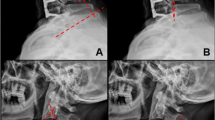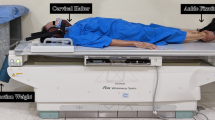Abstract
The insufficient investigations on the changes of spinal structures during traction prevent further exploring the possible therapeutic mechanism of cervical traction. A blind randomized crossover-design study was conducted to quantitatively compare the intervertebral disc spaces between axial and anterior lean cervical traction in sitting position. A total of 96 radiographic images from the baseline measurements, axial and anterior lean tractions in 32 asymptomatic subjects were digitized for further analysis. The intra- and inter-examiner reliabilities for measuring the intervertebral disc spaces were in good ranges (ICCs = 0.928–0.942). With the application of anterior lean traction, the statistical increases were detected both in anterior and in posterior disc spaces compared to the baseline (0.29 mm and 0.24 mm; both P < 0.01) and axial traction (0.16 mm and 0.35 mm; both P < 0.01). The greater intervertebral disc spaces obtained during anterior lean traction might be associated with the more even distribution of traction forces over the anterior and posterior neck structures. The neck extension moment through mandible that generally occurred in the axial traction could be counteracted by the downward force of head weight during anterior lean traction. This study quantitatively demonstrated that anterior lean traction in sitting position provided more intervertebral disc space enlargements in both anterior and posterior aspects than axial traction did. These findings may serve as a therapeutic reference when cervical traction is suggested.



Similar content being viewed by others
References
Akinbo SR, Noronha CC, Oke DA et al (2006) Effect of cervical traction on cardiovascular and selected ECG variables of cervical spondylosis patients using various weights. Niger Postgrad Med J 13:81–88
Cleland JA, Whitman JM, Fritz JM et al (2005) Manual physical therapy, cervical traction, and strengthening exercises in patients with cervical radiculopathy: a case series. J Orthop Sports Phys Ther 35:802–811. doi:10.2519/jospt.2005.0201
Colachis SC Jr, Strohm BR (1965) Cervical traction: relationship of traction time to varied tractive force with constant angle of pull. Arch Phys Med Rehabil 46:815–819
Deets D, Hands KL, Hopp SS (1977) Cervical traction. A comparison of sitting and supine positions. Phys Ther 57:255–261
DeLacerda FG (1979) Techniques in the application of cervical traction: a review of research findings. J Okla State Med Assoc 72:79–82
Demir T, Canakci V, Eltas A et al (2008) Effectiveness of mouthguards on tooth pain and mobility in cervical traction treatment. J Back Musculoskelet 21:91–98
Frobin W, Leivseth G, Biggemann M et al (2002) Vertebral height, disc height, posteroanterior displacement and dens-atlas gap in the cervical spine: precision measurement protocol and normal data. Clin Biomech (Bristol, Avon) 17:423–431. doi:10.1016/S0268-0033(02)00044-X
Ghoname EA, Craig WF, White PF et al (1999) Percutaneous electrical nerve stimulation for low back pain: a randomized crossover study. JAMA 281:818–823. doi:10.1001/jama.281.9.818
Graham N, Gross AR, Goldsmith C (2006) Mechanical traction for mechanical neck disorders: a systematic review. J Rehabil Med 38:145–152. doi:10.1080/16501970600583029
Hattori M, Shirai Y, Aoki T (2002) Research on the effectiveness of intermittent cervical traction therapy, using short-latency somatosensory evoked potentials. J Orthop Sci 7:208–216. doi:10.1007/s007760200035
Hollander E, Allen A, Kwon J et al (1999) Clomipramine vs desipramine crossover trial in body dysmorphic disorder: selective efficacy of a serotonin reuptake inhibitor in imagined ugliness. Arch Gen Psychiatry 56:1033–1039. doi:10.1001/archpsyc.56.11.1033
Humphreys SC, Chase J, Patwardhan A et al (1998) Flexion and traction effect on C5-C6 foraminal space. Arch Phys Med Rehabil 79:1105–1109. doi:10.1016/S0003-9993(98)90179-4
Jette DU, Falkel JE, Trombly C (1985) Effect of intermittent, supine cervical traction on the myoelectric activity of the upper trapezius muscle in subjects with neck pain. Phys Ther 65:1173–1176
Jones B, Kenward MG (1989) Design and analysis of cross-over trials: monographs on statistics and applied probability. Chapman & Hall, New York
Kitagawa T, Fujiwara A, Kobayashi N et al (2004) Morphologic changes in the cervical neural foramen due to flexion and extension: in vivo imaging study. Spine 29:2821–2825. doi:10.1097/01.brs.0000147741.11273.1c
Kolstad F, Myhr G, Kvistad KA et al (2005) Degeneration and height of cervical discs classified from MRI compared with precise height measurements from radiographs. Eur J Radiol 55:415–420. doi:10.1016/j.ejrad.2005.02.005
Krause M, Refshauge KM, Dessen M et al (2000) Lumbar spine traction: evaluation of effects and recommended application for treatment. Man Ther 5:72–81. doi:10.1054/math.2000.0235
Kroeber M, Unglaub F, Guehring T et al (2005) Effects of controlled dynamic disc distraction on degenerated intervertebral discs: an in vivo study on the rabbit lumbar spine model. Spine 30:181–187. doi:10.1097/01.brs.0000150487.17562.b1
Kroeber M, Unglaub F, Wang H et al (2002) New in vivo animal model to create intervertebral disc degeneration and to investigate effects of therapeutic strategies to stimulate disc regeneration. Spine 27:2684–2690. doi:10.1097/00007632-200212010-00007
Kwon BK, Song F, Morrison WB et al (2004) Morphologic evaluation of cervical spine anatomy with computed tomography: anterior cervical plate fixation considerations. J Spinal Disord Tech 17:102–107
Lee RYW, Evans JH (2001) Loads in the lumbar spine during traction therapy. Aust J Physiother 47:102–108
Liu J, Ebraheim NA, Sanford CG Jr et al (2008) Quantitative changes in the cervical neural foramen resulting from axial traction: in vivo imaging study. Spine J 8:619–623. doi:10.1016/j.spinee.2007.04.016
Lu J, Ebraheim NA, Huntoon M et al (2000) Cervical intervertebral disc space narrowing and size of intervertebral foramina. Clin Orthop Relat Res 370:259–264. doi:10.1097/00003086-200001000-00026
Moeti P, Marchetti G (2001) Clinical outcome from mechanical intermittent cervical traction for the treatment of cervical radiculopathy: a case series. J Orthop Sports Phys Ther 31:207–213
Muggleton JM, Allen R (1998) Insights into the measurement of vertebral translation in the sagittal plane. Med Eng Phys 20:21–32. doi:10.1016/S1350-4533(97)00045-3
Olivero WC, Dulebohn SC (2002) Results of halter cervical traction for the treatment of cervical radiculopathy: retrospective review of 81 patients. Neurosurg Focus 12:ECP1. doi:10.3171/foc.2002.12.2.4
Onel D, Tuzlaci M, Sari H et al (1989) Computed tomographic investigation of the effect of traction on lumbar disc herniations. Spine 14:82–90. doi:10.1097/00007632-198901000-00017
Ozturk B, Gunduz OH, Ozoran K et al (2006) Effect of continuous lumbar traction on the size of herniated disc material in lumbar disc herniation. Rheumatol Int 26:622–626. doi:10.1007/s00296-005-0035-x
Pfeiffer M, Geisel T (2003) Analysis of a computer-assisted technique for measuring the lumbar spine on radiographs: correlation of two methods. Acad Radiol 10:275–282. doi:10.1016/S1076-6332(03)80101-0
Pio A, Rendina M, Benazzo F et al (1994) The statics of cervical traction. J Spinal Disord 7:337–342. doi:10.1097/00002517-199408000-00008
Reitman CA, Mauro KM, Nguyen L et al (2004) Intervertebral motion between flexion and extension in asymptomatic individuals. Spine 29:2832–2843. doi:10.1097/01.brs.0000147740.69525.58
Saunders HD (1983) Use of spinal traction in the treatment of neck and back conditions. Clin Orthop Relat Res 179:31–38. doi:10.1097/00003086-198310000-00006
Sohn HM, You JW, Lee JY (2004) The relationship between disc degeneration and morphologic changes in the intervertebral foramen of the cervical spine: a cadaveric MRI and CT study. J Korean Med Sci 19:101–106
Vaughn HT, Having KM et al (2006) Radiographic analysis of intervertebral separation with a 0 degrees and 30 degrees rope angle using the Saunders cervical traction device. Spine 31:E39–E43. doi:10.1097/01.brs.0000194840.42792.f2
Wang B, Liu H, Wang H et al (2006) Segmental instability in cervical spondylotic myelopathy with severe disc degeneration. Spine 31:1327–1331. doi:10.1097/01.brs.0000218508.86258.d4
Wong AM, Lee MY, Chang WH et al (1997) Clinical trial of a cervical traction modality with electromyographic biofeedback. Am J Phys Med Rehabil 76:19–25. doi:10.1097/00002060-199701000-00005
Wong AM, Leong CP, Chen CM (1992) The traction angle and cervical intervertebral separation. Spine 17:136–138. doi:10.1097/00007632-199202000-00004
Wu SK, Kuo LC, Lan HC et al (2007) The quantitative measurements of the intervertebral angulation and translation during cervical flexion and extension. Eur Spine J 16:1435–1444. doi:10.1007/s00586-007-0372-4
Acknowledgments
No funds were received in support of this study.
Conflict of interest statement
No benefits in any form have been or will be received from a commercial party related directly or indirectly to the subject of this manuscript.
Author information
Authors and Affiliations
Corresponding author
Rights and permissions
About this article
Cite this article
Chung, CT., Tsai, SW., Chen, CJ. et al. Comparison of the intervertebral disc spaces between axial and anterior lean cervical traction. Eur Spine J 18, 1669–1676 (2009). https://doi.org/10.1007/s00586-009-1072-z
Received:
Revised:
Accepted:
Published:
Issue Date:
DOI: https://doi.org/10.1007/s00586-009-1072-z




